It's quick simple to make this fiery, sweet, light-as-a-feather gingerbread Swiss roll, filled with with creamy, cool lemon buttercream.

To make the sponge, you'll simply whisk eggs and brown sugar together until creamy, then fold in self-raising flour and ground ginger to create an airy batter, which you'll pour into a tin and bake in just 8 minutes.
You'll then follow my easy method (complete with step-by-step pics) to achieve the perfect roll with no cracks. It involves rolling the up with a tea towel while it's warm so that it cools with a natural curve - clever, huh?

Then it's just a case of unrolling your cooled sponge, spreading with the lemon buttercream and rolling back up to create this dreamy, delicious ginger dessert.

Ingredients
For the sponge
- 3 medium free range eggs
- 100 g (½ cup + 1 tbsp) soft light brown sugar
- 100 g (⅔ cups) plain white flour (all purpose flour)
- 2 tbsp ground ginger
To dust
- 2 tbsp icing sugar (powdered sugar)
For the filling
- 150 g (1 stick + 3 tbsp) salted butter
- 260 g (2 cups) icing sugar (powdered sugar)
- 30 ml (2 tbsp) whole milk
- 75 g (2½ oz) white chocolate melted
- 1 lemon zested
To serve
- 1 tbsp icing sugar (powdered sugar)
Equipment
- Rectangle 23x33cm (9"x13") nonstick swiss roll tin
Instructions
Preheat the oven to 200C (180C fan).
Grease the Swiss roll tray and line with baking paper.

Make the sponge
Put the eggs and sugar in a large mixing bowl.

Whisk until thick, pale and considerably increased in volume. This will take a few minutes.
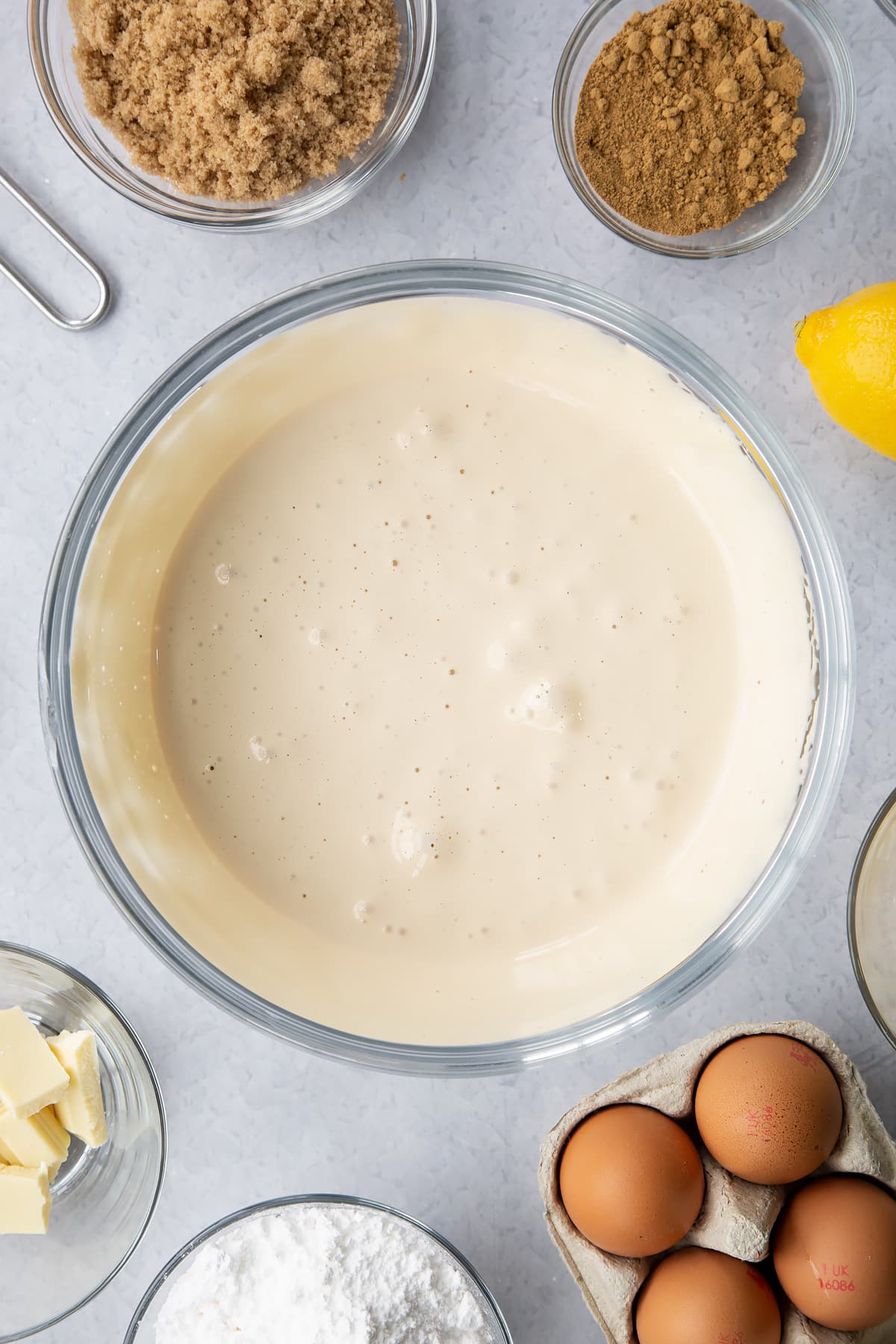
Sift in the flour and ginger.

Fold through gently with a silicone spatula or large metal spoon.

Tip the mixture into the lined tin and gently level off.

Bake for 8 minutes until just firm.
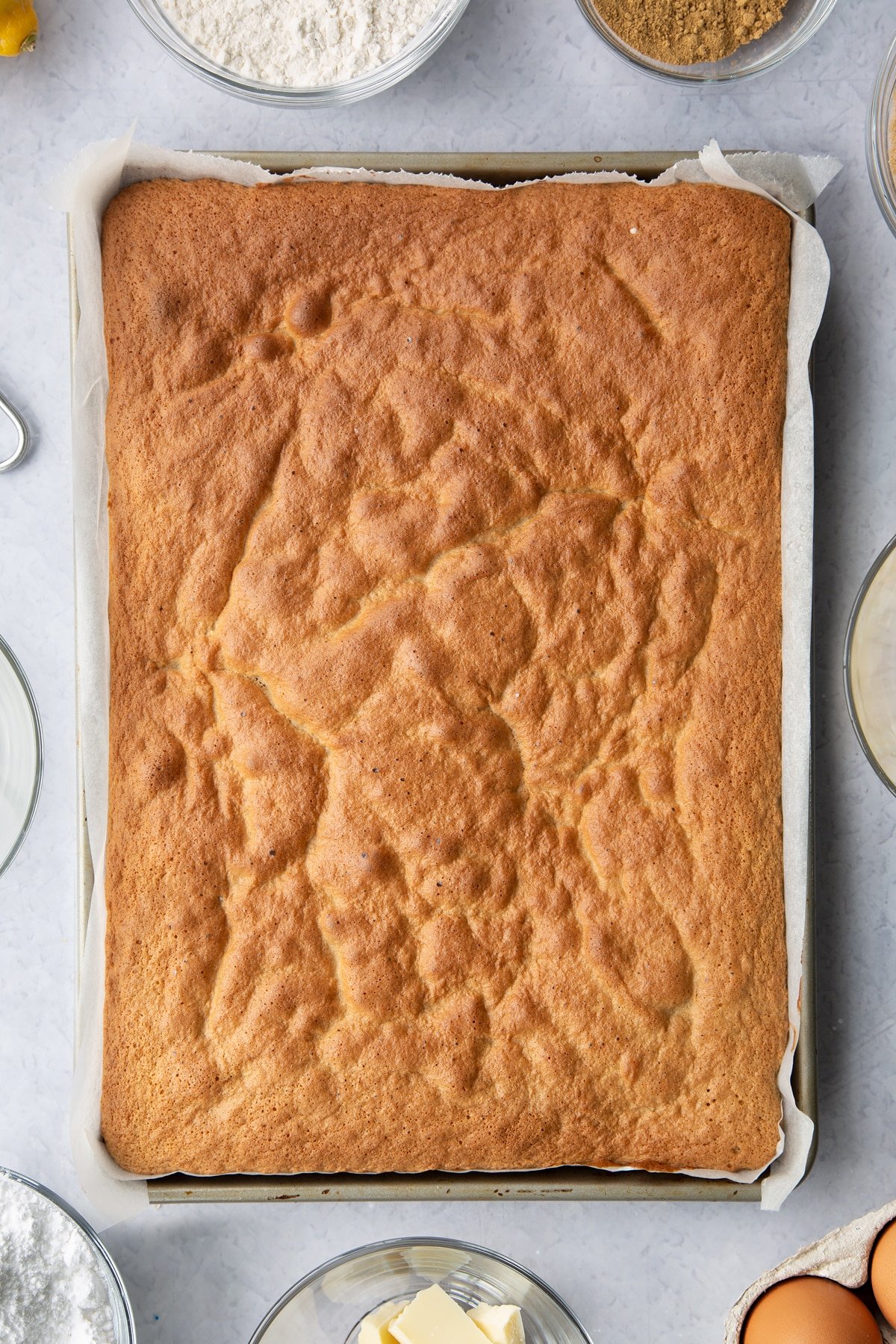
Shape the Swiss roll
Lay a rectangle of baking paper out on your counter. Sift the icing sugar all over the paper.
Turn the hot Swiss roll sponge out onto the baking paper.

Carefully peel off the paper backing.

Lay a clean tea towel on top of the Swiss roll sponge.
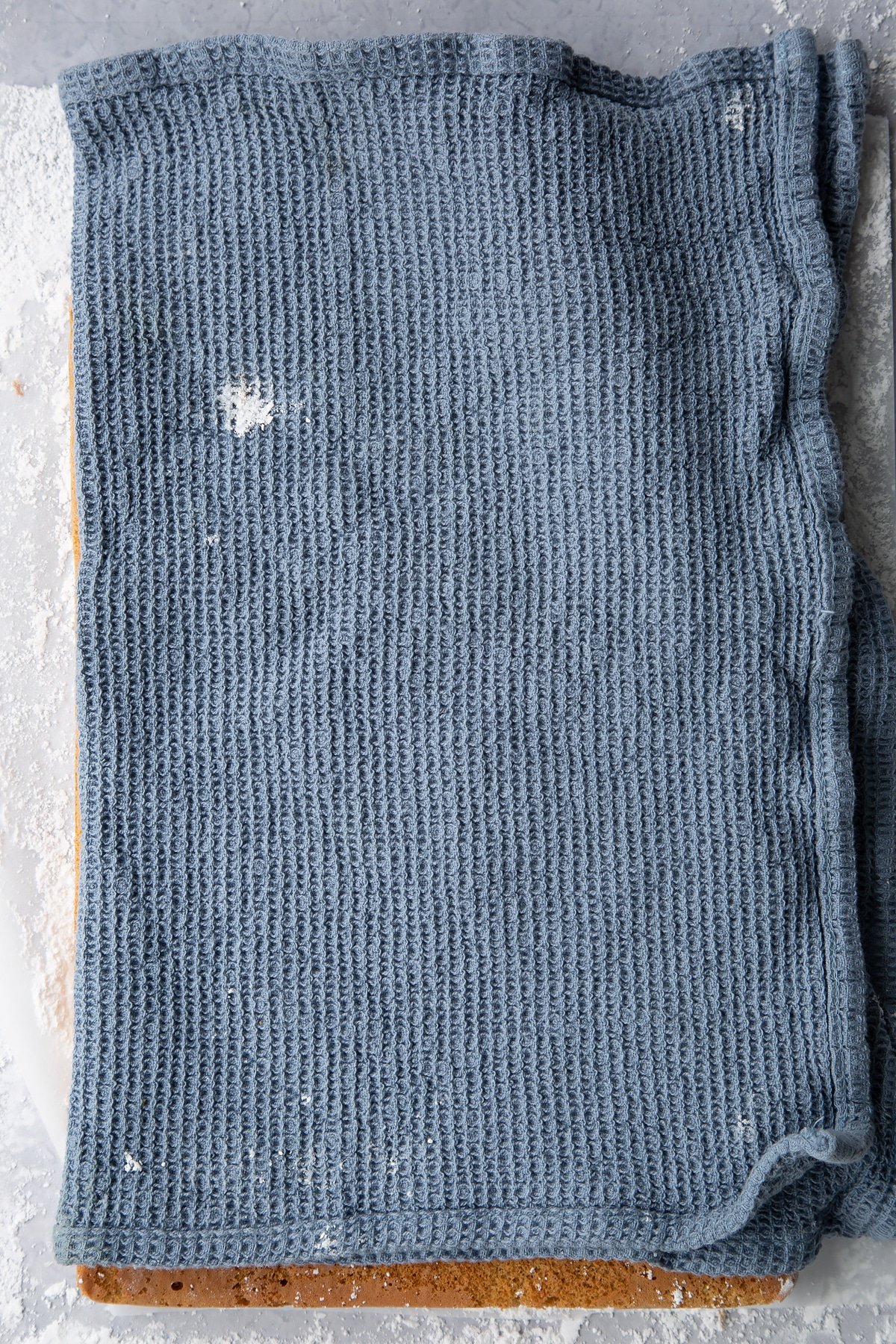
Carefully roll the sponge up with the tea towel and baking paper. Leave rolled up to cool completely.

Make the frosting
You can make the frosting while the sponge is cooling. Melt the white chocolate and set aside to cool.
Put the icing sugar, butter and milk in a mixing bowl.

Whisk together until pale, smooth and considerably increased in volume.

Add the lemon zest.

Whisk again to distribute.

Add the cooled white chocolate.

Whisk again to produce a smooth lemon frosting.
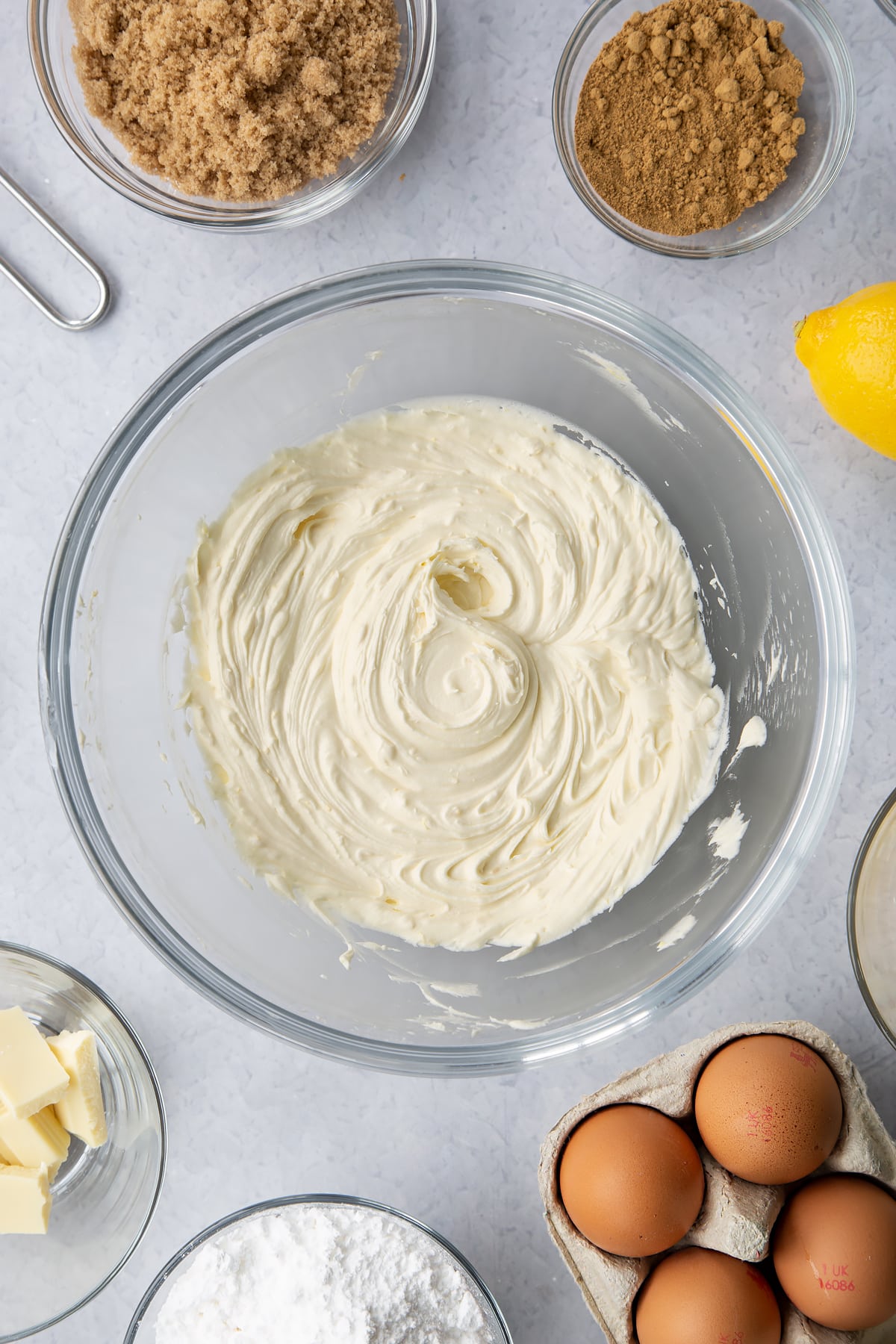
Fill the Swiss roll
Carefully unroll the totally cooled sponge.

Spoon the frosting on top.

Spread to the edges.
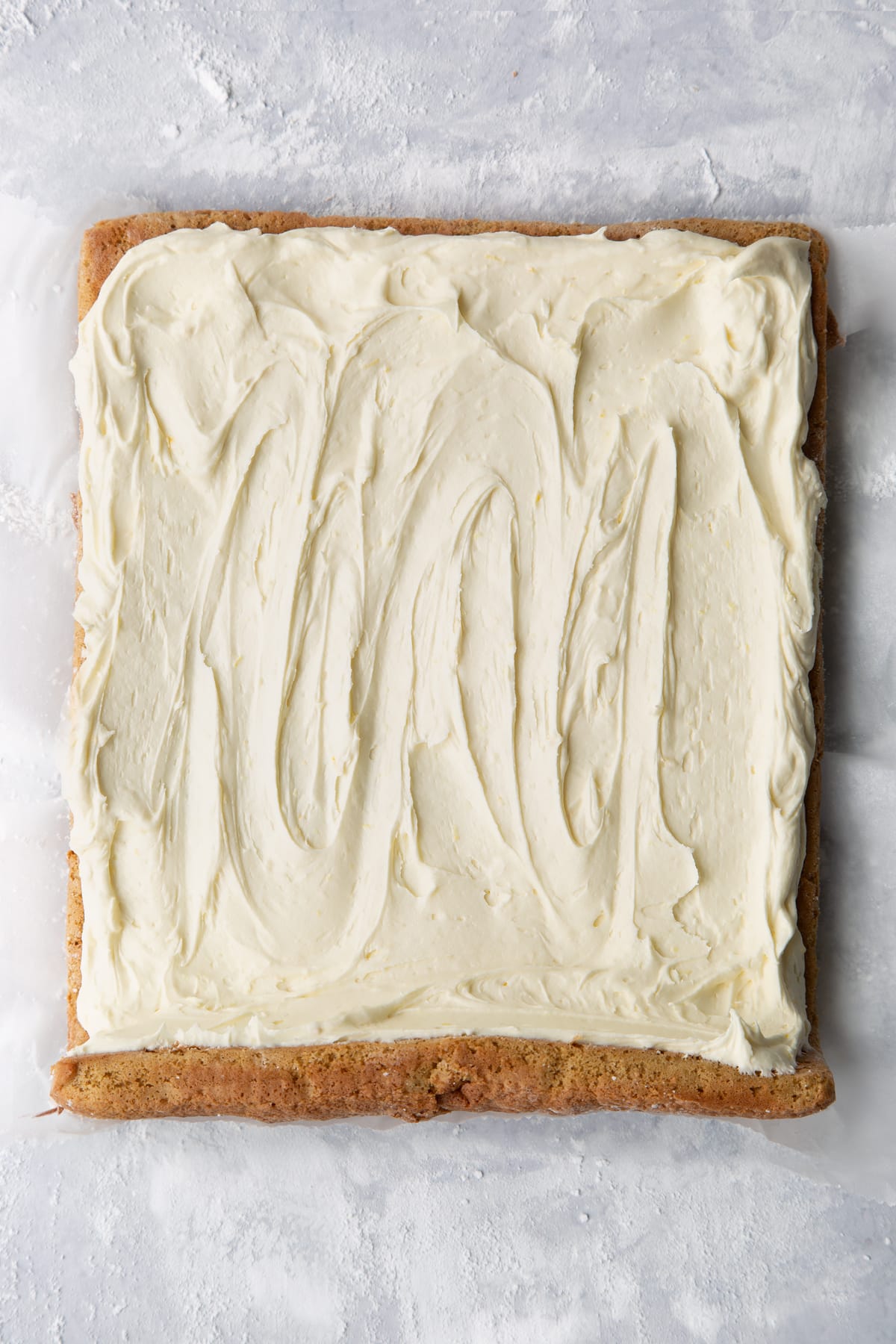
Roll back up, this time without taking the baking paper with it.
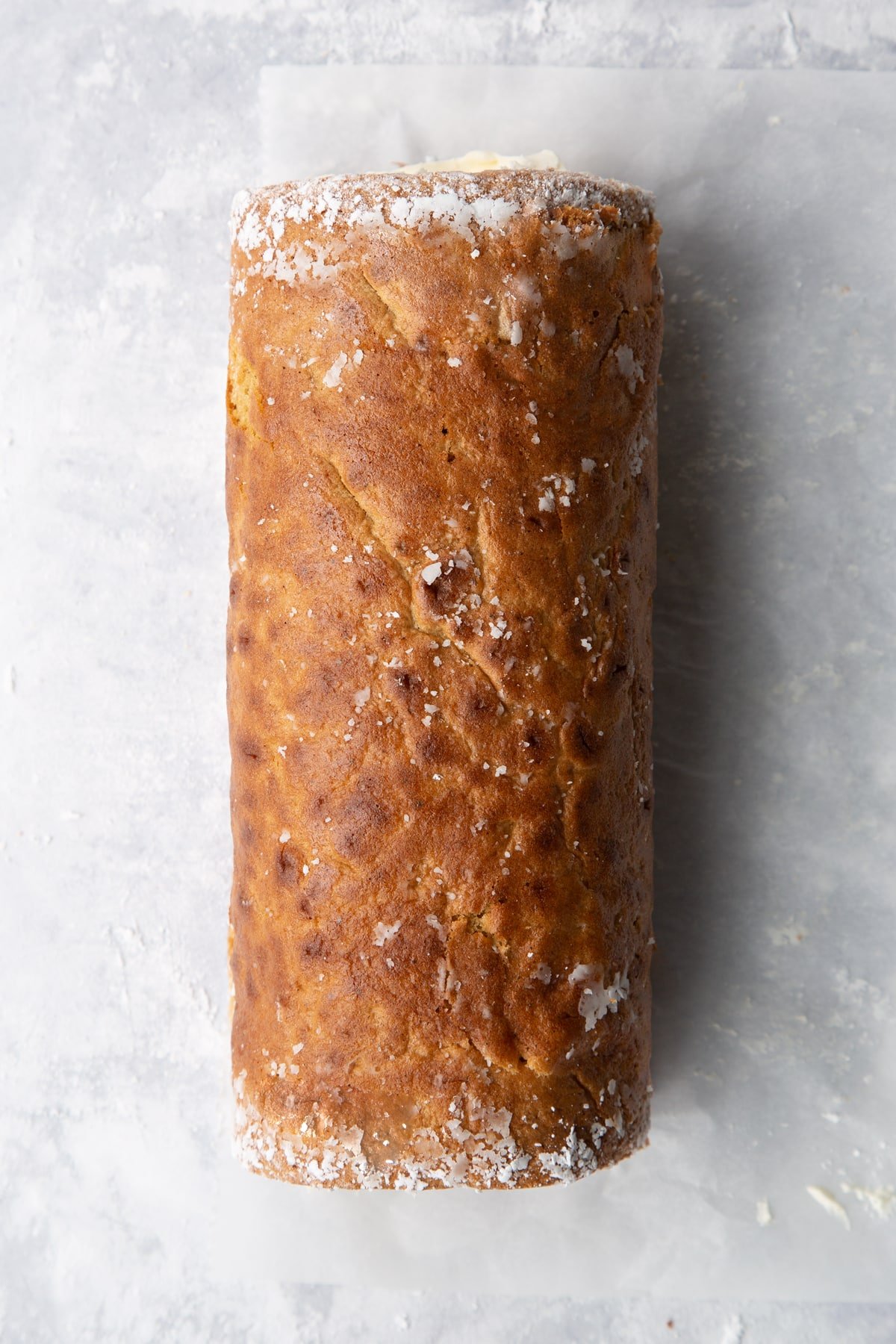
Transfer to a serving board or plate and dust lightly all over with the icing sugar.
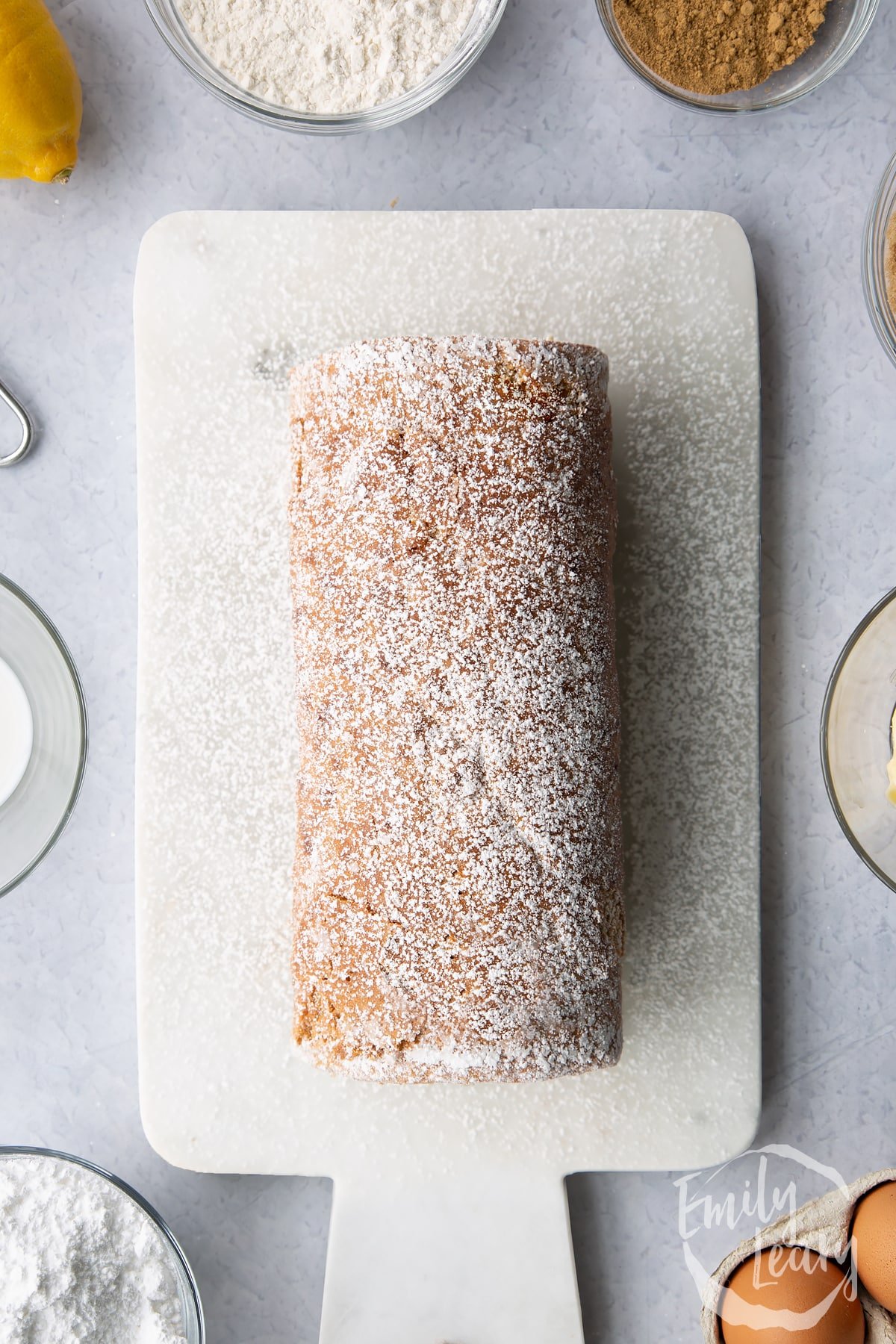
Slice with a sharp, serrated knife to serve.
Meanwhile, you'll make the buttercream by whisking icing sugar, butter and milk together until light and fluffy and then folding in melted white chocolate and lemon zest to give stability, creaminess and flavour. Delicious!

Pointers, tricks and troubleshooting tips for the perfect gingerbread Swiss roll
Is gingerbread Swiss roll easy to make?
Yes, it's essentially a sponge cake recipe, so you don't need to be an expert baker. Instead, it's all about timing. So the only skill is in making sure you roll your sponge layer while it's still warm.
So with the easy-to-follow step-by-step guide and pictures, this gingerbread Swiss roll is an easy showstopper.
Will I need any special equipment to make this gingerbread Swiss roll?
To make the gingerbread sponge layer and filling, you'll need some standard baking equipment (bowls, scales, spoons, etc.) listed in the recipe card below. If you don’t have a stand mixer, feel free to whisk the sponge mixture by hand, but an electric mixer will save you some strength.
Baking parchment and a clean dish towel are essential equipment for getting a perfect roll. So make sure you have them available when your sponge comes out of the oven.
The only thing you might not have at home is a Swiss roll tray. A Swiss roll tray is just a large sheet pan that is at least a couple of inches deep. You'll need to use a pan like this, rather than a flat or shallow baking tray, so you get an even sponge layer to roll.
Where can I buy a Swiss roll tray?
You can usually find inexpensive Swiss roll trays in the kitchenware section of a large supermarket, a homeware store, or they're available on Amazon.

How can I tell if my eggs have gone bad?
Egg storage is related to temperature, so safety standards and storage advice are different depending on the country you live in. However, eggs are widely known to be a potential carrier for salmonella if not stored or handled correctly. So it's always safest to use fresh eggs when cooking.
Eggs are usually stored at room temperature in UK supermarkets, whereas eggs are typically found in refrigerated sections in the US or some European countries. In Australia, it's recommended that you keep eggs below 15C.
In the US and Australia, eggs are prewashed before being shelved, whereas in the UK, this isn't always the case - you'll be able to tell if you find a telltale feather in your carton. So even if your eggs are fresh, it's worth giving the shells a quick wash so you don't end up spitting feathers.
In the UK, there are two dates given on food products, the 'Best Before End' or 'Use By' dates. In the US, food only has an 'Expiration Date'. Unlike 'Use By' dates, which are essential food safety dates that should always be adhered to, Best Before / Expiration dates are more about eating the food before the quality declines. Eggs in the UK will have a Best Before End date stamped on them, so even if you keep your eggs in a bowl, you'll still be able to tell how fresh they are.
It's important to note that these dates are given on the assumption that you have stored your food as the label tells you to. So if your eggs say 'refrigerate' and you've left them on the counter for a couple of weeks, their Use By date might be shorter.
Food Use By dates are usually a very conservative estimation. In the UK and US, if your eggs have been properly stored in the refrigerator after coming home from the store, they may be safe to eat after the date stamped on them. The NHS has more UK-specific advice on this.
There's a commonly known test to tell if your egg is fresh, called the float test. As it implies, you place your egg in a cup or bowl of water to see if it sinks or floats. Fresh eggs will sink to the bottom of the water as they have little gas within them. Older eggs will float because eggs gradually lose water content and absorb air through their shells. However, this test isn't recommended as bad eggs can still sink.
If your egg looks, smells, feels or tastes odd in any way, even if it's in date, don't risk it. It's never worth the risk of salmonella or food poisoning.
Food safety is especially important if you're an older person, live with an underlying health condition, or are pregnant. If you're unsure, always check the health or food safety guidelines wherever you live.
Note: This site does not give medical advice, so please consult with your medical professional.
How can I tell if my ginger has lost it’s flavour?
Ground ginger should almost tickle your nose like the smell of black pepper. If you don't smell much ginger when you open the container, it's probably not at its best.
It varies by brand, but sometimes ground ginger that seems pretty mellow can come to life when heated up. So, you could try gently heating half a teaspoon of ginger in a saucepan with some butter or oil. It will probably be fine for the gingerbread Swiss roll if it becomes fragrant and has that classic ginger spice punch. But as usual, buying in date and fresher ingredients is always best.
However, using a fresh ginger root wouldn't be suitable for this recipe as the flavour is so much more intense than ground ginger. Equally, stem or candied ginger is much too mild.

Is gingerbread Swiss roll suitable for vegetarians?
Yes, this recipe contains no meat, so it's suitable for vegetarians.
However, it's worth noting that some dessert sauces or sweets can contain animal-derived products which aren't suitable for vegetarians. So even if you think an ingredient is vegetarian, it's always worth checking the packets if it's an unfamiliar brand or product.
Remember to check the labels for any sauces or extras you plan to serve with the gingerbread Swiss roll.
Is gingerbread Swiss roll suitable for vegans?
This recipe contains eggs and dairy ingredients (butter and chocolate) in both the cake and the filling, so it isn't suitable for vegans. However, you could try to adapt the recipe with some vegan replacements.
There are many great vegan alternatives for butter, egg and chocolate, and they're becoming increasingly widespread as plant-based diets become more popular.
You can replace the butter in the cake and the filling with plant-based vegan butter. Depending on where you live, there will be different brands available, but you should try and use vegan butter with a fat content of around 80% fat so that it works similarly to butter in the sponge and the filling.
You can replace eggs with one of the options below (each = 1 egg, so multiply by 3 for this recipe):
- 3 tablespoons of aquafaba (the water you get in a tin of chickpeas).
- 1 tablespoon of crushed chia seeds or flax seeds mixed with 2 tablespoons of water and left for 10 minutes in the fridge.
- 3 tablespoons of applesauce (bear in mind this will add sweetness and potentially an apple flavour).
You can also buy ready-prepared vegan egg replacements from supermarkets, health food stores or online. These ready-prepared egg replacers are usually similar to the DIY versions above, made with chia or flax.
Vegan chocolate is available in most supermarkets or health food stores. Even the UK’s biggest chocolate brand, Cadburys, recently launched their own vegan chocolate. You can also buy many variations of vegan chocolate online. It might be best to find a version that is made for baking, as the different fat content and dairy replacement used might act differently to dairy chocolate.
Double-check all of your ingredient labels to check that they are suitable for vegans. Also, don't forget to check anything extra like sauces or custards that you intend to serve with the gingerbread Swiss roll.
Is gingerbread Swiss roll gluten-free?
This gingerbread Swiss roll recipe isn't gluten-free, as it contains wheat flour. The recipe also calls for chocolate, which is typically gluten-free, but some brands may sneak in wheat-derived products or produce it in a factory where gluten is present.
I haven't tried making this recipe with gluten-free flour, but you could try and adapt it yourself. There are plenty of great gluten-free baking products that could help.
I recommend using a gluten-free baking flour with a blend of different flours like rice or oat mixed with a binding agent like xanthan gum which helps give your cake a good texture. Don't forget to make sure your gluten-free flour includes a raising agent.
The cooking time and temperature should be the same if you use gluten-free flour, but you should consult your packet as the brand might have guidelines for making a cake with their particular gluten-free flour.
When cooking for someone with intolerances or allergies, it's especially important to double-check all of your ingredient labels to check that they are suitable for people who don't eat gluten.
Also, don't forget to check anything extra like sauces or custards you intend to serve with the gingerbread Swiss roll. You'd be surprised how often gluten can sneak into an unexpected product.
Is gingerbread Swiss roll keto-friendly?
This recipe calls for sugar and flour, so it's not compatible with a keto diet. You could try to make the sponge and frosting with keto flour and keto sugar but it probably wouldn’t taste or look similar.
Is gingerbread Swiss roll healthy?
While this gingerbread Swiss roll is light and delicious, it isn't particularly healthy as it contains a fair amount of sugar. But there's nothing wrong with enjoying an occasional treat as part of a healthy diet.
Is gingerbread Swiss roll safe to eat while pregnant?
According to UK guidelines, nothing in this recipe should present a risk to pregnant people. So as long as you make sure that all the ingredients are in good condition and this meal is prepared safely and hygienically, it should be safe to eat.
Most dairy butter and milk in the UK is pasteurised. However, it's always best to check if you're unsure, as pregnant people should not eat unpasteurised dairy. The NHS has some really clear and helpful information here. Dairy safety regulations can vary by country, so you should consult your local guidelines or a medical professional if you're unsure.
Egg safety advice varies depending on where you live, as production and storage methods differ in different countries, so please check information locally. In the UK, at the time of writing (November 2021), The Advisory Committee on the Microbiological Safety of Food advises that eggs with the British Lion mark of quality are safe for pregnant people to eat runny or even raw.
A Mummy Too does not offer medical advice. Please seek help from a medical professional if you need further information or have any concerns.

What goes well with this gingerbread Swiss roll?
Gingerbread is a classic winter flavour, so this gingerbread Swiss roll would go well with festive flavours like orange, nutmeg, cinnamon and of course almost anything goes with chocolate.
While the Swiss roll has a white chocolate filling, you can still serve it with a sauce, ice cream, or even drizzled with some tempered chocolate for the ultimate indulgence.
Can I make this recipe without ginger?
Sure, it’s fine to make this recipe without ginger but remember the ginger is what gives it that cosy Gingerbread flavour. Swiss rolls are easy to adapt to other flavours. I have another recipe if you want a more chocolatey Swiss roll or you could try and make one of these Swiss roll recipes.
(I wasn’t sure if internal linking is redundant because of the internal linking project, so let me know if I should avoid internal links for now)
Can I leave the lemon out of the buttercream?
Sure, you can leave the lemon out of the buttercream and it won’t affect the recipe. If you prefer you could even add lemon zest or another flavour like vanilla or cinnamon.
I haven’t got brown sugar, can I use white sugar?
You can use white sugar in this recipe, but it might affect the texture of your Swiss roll so it’s best to stick to brown sugar. Brown sugar is sugar that has had molasses added to it. This gives it that moist texture, which helps to give your Swiss roll a softer texture.
The softer texture of the sponge is important, as it makes it easier to shape when it’s warm and reduces the chance of the sponge drying out or cracking as you roll it.
Can I add extra ginger to this recipe?
If you love ginger, feel free to add extra ginger to the recipe. However, it might be a good idea to make a little test sponge with extra ginger added to it before you commit to incorporating extra ginger in your recipe. This is because dried ginger can be deceptively mellow before it’s cooked so you could end up with a much too intense ginger flavour.
How should I store gingerbread Swiss roll?
This gingerbread Swiss roll has a buttercream filling which means it needs to be refrigerated. So it’s best to keep your Swiss roll in an airtight container in your fridge.
How long does gingerbread Swiss roll keep?
If you store your gingerbread Swiss roll in a sealed container in the fridge, it should keep for 3-5 days.
In the freezer, leftover slices should keep for up to 3 months.
Can I leave gingerbread Swiss roll out on the counter?
No, your gingerbread Swiss roll will have a buttercream filling that contains milk and butter so it needs to be refrigerated or if you want to keep it for longer, frozen.
Can I make gingerbread Swiss roll ahead?
The key to getting a perfect gingerbread Swiss roll is rolling it as soon as it comes out of the oven, so it’s best to make the sponge on the day you want to serve it. If you rolled the Swiss roll and left it for a day before adding the filling it might become too brittle and break apart.
You can make your frosting a couple of days in advance, as long as you store it in the fridge in an airtight container.
Can I keep gingerbread Swiss roll in the refrigerator?
Yes, the best way to store your Swiss roll is in an airtight container in your fridge. As it contains a buttercream filling it should last for around 3-5 days, though of course, it’s always best at its freshest.
Can I freeze gingerbread Swiss roll?
Yes, this gingerbread Swiss roll should freeze well.
It's best to freeze it when it's fresh so that you can save it at its best. You could freeze the whole Swiss roll in a sealed container, or you can slice it up first. That way, you can grab a slice as needed without wasting any leftovers.
If you decide to freeze it in slices, it's best to layer a piece of baking paper between the slices, so they don't stick together. This will also make it easier for you to take slices out as you need them.
Your frozen gingerbread Swiss roll will keep in the freezer for up to 3 months.
What is the best way to defrost gingerbread Swiss roll?
Whether you defrost your Swiss roll whole or in slices, it's best to defrost it in the fridge in a sealed container.
Defrosting it in the fridge rather than on the counter will let your Swiss roll defrost gradually and evenly, and you won't risk the buttercream frosting melting.
Can I make gingerbread Swiss roll in a size or quantity?
If you want to make a bigger or smaller gingerbread Swiss roll, that's totally fine.
A helpful tool in the recipe card below can help you work out the ratios and amounts needed to reduce or increase the recipe. Look for the servings section near the top of the card.
To change this to the number of servings you want to make, just click on it, and then a little slider will pop up. You can move the slider up or down to get the amount you want to make.
All the ingredient quantities will update automatically for you so that everything is in the correct ratios.
However, with this Swiss roll recipe, it might be best not to go too much bigger or smaller, as it will be more challenging to roll the sponge layer if it is too small or too big.
Can I make gingerbread Swiss roll in individual mini portions?
In theory, you could make mini Swiss rolls, but it might be difficult to get a good roll if they’re much smaller.
If you’re feeling confident you could experiment with ways to make the sponge more malleable. The high egg content and moistness of the brown sugar helps give this Swiss roll a softer flexible texture, so perhaps experimenting with an extra egg or swapping some sugar out for golden syrup could be a route to explore.

Can I make gingerbread Swiss roll in a stand mixer such as a KitchenAid or Kenwood Mixer?
A stand mixer would be ideal for mixing the eggs and sugar in this recipe. However, take care not to overmix your Swiss roll mix once the flour has been added. Overmixing flour in a cake mix can sometimes cause the gluten to become too activated which leads to a tough sponge. If this happens your sponge layer might become too tough and it will make rolling it difficult.
Can I make gingerbread Swiss roll with a food processor?
A food processor wouldn’t really work for this recipe as you need to make sure your cake mixture has enough air in it to rise.
A food processor has a blade attachment which won't work as well as a whisk.
How can I make sure my Swiss roll sponge is perfectly cooked?
The sponge element of this recipe should cook quite quickly as it is filled with air and has a large surface area.
After the 8 minute cooking time, it should look like it is dry across the top but not stiff or cracked. The edges may look slightly more browned than the centre, but this is fine as long as it's cooked all the way across. Pressing your finger into the centre should find a just firm sponge.
Keep an eye on your sponge for the last few minutes to make sure it doesn’t overcook. A dry, overcooked sponge will crack and break apart when you try to roll it.
Why did my gingerbread sponge come out really thin and dense?
If your gingerbread sponge came out thin, dense and very flat there are a couple of potential causes.
This recipe needs a very light and airy sponge mixture, which means getting the mixing part right is important. If the eggs weren’t whisked enough there might not have been enough air in the batter.
Equally, if the flour wasn’t sifted as it was incorporated then the batter might have had dense lumps in it.
If you got distracted in the middle of making the batter, you might have let it sit too long which would cause the batter to lose air and become flat. So make sure you get the batter into the oven as soon as it’s ready to ensure you get the fluffiest sponge.
Another reason your sponge turned out flat could be that you accidentally used plain flour instead of self-raising flour. Some stores have different colours for plain and self-raising flour so don’t worry, it can happen to the best of us! Next time make sure to double-check the label.
Why can't I roll my gingerbread sponge? Why did my sponge crack when rolled?
If your gingerbread sponge is cracking when you try to roll it, then it sounds like it could be too dry or overcooked. Make sure you monitor your sponge for it’s last few minutes in the oven so you can pull it out if it looks cooked before the timer goes off.
However, if you followed the recipe exactly and it’s still overcooked after 8 minutes, your oven might be running hotter than the dial states. Don’t worry, inconsistent oven temperatures are common in most household ovens. It’s usually not enough to notice but becomes clear during recipes like this where the thin sponge can dry out quickly. So if you suspect your oven isn’t cooking consistently it could be worth picking up an oven thermometer so you can ensure your bakes cook correctly.

Why did my Swiss roll squash when I cut it?
I guessed these answers from past experience as I couldn’t find much information online to confirm it:
If your gingerbread Swiss roll has squashed together when you cut into it, it could be too moist or dense. If it’s too moist, you might not have used enough flour. If it’s too dense it might be because your batter didn’t have enough air in which is caused by under mixing, or by leaving your batter sat too long before baking it.
Or if you’re using gluten-free flour or vegan ingredients they might react differently than the original recipe, so it could take a bit of trial and error to get the ratio correct if you’re experimenting with alternative ingredients.
It’s also possible your knife is just too blunt.
How can I add/change the flavours in my gingerbread Swiss roll?
If you want to customize your gingerbread Swiss roll, you can add alternative flavours to the batter or the frosting.
Gingerbread is a classic winter flavour so it would go well with other spices and flavours you might see then, like nutmeg, cinnamon, or for more of a grown-up flavour, cloves or anise. You could add 1/2 teaspoon of these spices to the sponge mix without it impacting the bake time or texture. Or you could add them to the buttercream frosting. You could also add orange zest to either the sponge or the frosting.
If you prefer milk chocolate you could swap it with the white chocolate in the frosting. White chocolate and milk chocolate have the same melting point, so it shouldn’t affect the recipe method. If you used dark chocolate, which is another classic combination with ginger, you would need to melt the chocolate for a little longer as dark chocolate has a higher melting point than milk or white chocolate.
Did the Swiss roll really originate in Switzerland?
Despite the name, it’s unclear where the Swiss roll came from. Rolled and filled cakes have been around since at least the mid 17th century with various names.
The term ‘Swiss Roll’ started appearing in cookbooks and recipes from Britain and America in the 1800s.
Many different countries have recipes for rolled and filled cakes with different names. So it could have originated in Italy or Indonesia, it remains a delicious mystery.
Print this gingerbread Swiss roll recipe
Gingerbread Swiss Roll Recipe
Ingredients
For the sponge
- 3 medium free range eggs
- 100 g (½ cup + 1 tbsp) soft light brown sugar
- 100 g (⅔ cups) plain white flour (all purpose flour)
- 2 tbsp ground ginger
To dust
- 2 tbsp icing sugar (powdered sugar)
For the filling
- 150 g (1 stick + 3 tbsp) salted butter
- 260 g (2 cups) icing sugar (powdered sugar)
- 30 ml (2 tbsp) whole milk
- 75 g (2½ oz) white chocolate melted
- 1 lemon zested
To serve
- 1 tbsp icing sugar (powdered sugar)
Equipment
- Rectangle 23x33cm (9"x13") nonstick swiss roll tin
Instructions
- Preheat the oven to 200C (180C fan / 390F).
- Grease the Swiss roll tray and line with baking paper.
Make the sponge
- Put the eggs and sugar in a large mixing bowl. Whisk until thick, pale and considerably increased in volume. This will take a few minutes.
- Sift in the flour and ginger. Fold through gently with a silicone spatula or large metal spoon.
- Tip the mixture into the lined tin and gently level off.
- Bake for 8 minutes until just firm.
Shape the Swiss roll
- Lay a rectangle of baking paper out on your counter. Sift the icing sugar all over the paper.
- Turn the hot Swiss roll sponge out onto the baking paper. Carefully peel off the paper backing.
- Lay a clean tea towel on top of the Swiss roll sponge.
- Carefully roll the sponge up with the tea towel and baking paper. Leave rolled up to cool completely.
Make the frosting
- You can make the frosting while the sponge is cooling. Melt the white chocolate and set aside to cool.
- Put the icing sugar, butter and milk in a mixing bowl. Whisk together until pale, smooth and considerably increased in volume.
- Add the lemon zest and whisk again to distribute.
- Add the cooled white chocolate. Whisk again to produce a smooth lemon frosting.
Fill the Swiss roll
- Carefully unroll the totally cooled sponge.
- Spoon the frosting on top, spreading to the edges.
- Roll back up, this time without taking the baking paper with it.
- Transfer to a serving board or plate and dust lightly all over with the icing sugar.
- Slice with a sharp, serrated knife to serve.
Video
Nutrition
Pin this gingerbread Swiss roll recipe

More recipes to try
Have you got my book?

'This is a great kids cookery book. Emily is a star' - Simon Rimmer
'The book I'd like to force into any mother's kitchen' - Prue Leith
"A fab book with a plan." - Jane Devonshire, 2016 Masterchef UK winner
'Emily has managed to combine her mummy knowledge and passion for food to make a truly helpful and brilliant cookbook' - Priya Tew, RD, BSc (Hons), Msc
Get Your Kids to Eat Anything is an achievable 'how to' for parents in the battle to overcome picky eating and 'make new the norm'. Emily Leary's unique 5-phase programme looks at the issue of 'fussy eating' in a holistic way that links imagination with food, and which situates parents alongside - not in opposition to - their children.

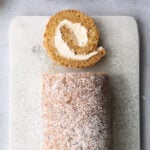
Leave a Reply